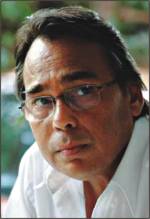Mirror shots & how not to be a photographer
 It all starts with an exquisite picture. The picture draws them in, gets inside the Reserved-for-WOW part of their brains and suddenly, they decide they're obsessed. After countless... minutes of browsing for more wondrous pictures, they come across THE ONE.
It all starts with an exquisite picture. The picture draws them in, gets inside the Reserved-for-WOW part of their brains and suddenly, they decide they're obsessed. After countless... minutes of browsing for more wondrous pictures, they come across THE ONE.
“Hey! I bet I could take a picture like that. I know just the place...”
And that's only the beginning. Armed with their very own DSLR camera, they hunt for their next meal, err, shot. The very first shot: Subject (self) behind the camera (pointed at the mirror) shot. Then it's straight to Facebook to establish their newfound photographer status by making that shot their profile picture. Running around the city looking for plausible subjects, the camera strap barely keeping the camera hanging around their neck (not for the attention of course, just for convenience), they look for The Perfect Shot, the next photo to upload to their (insert witty interpretation of photography) Album on Facebook.
The Special Effects
It doesn't take them very long (definitions of very long may vary) to realise that there are special effect functions in the camera. Thank God for preset Portrait, Landscape and all those other settings. Shutter Speed and Aperture are so HARD to use. How is a person supposed to remember whether increasing aperture makes the closer things more blurry or less blurry? And what is the difference between M and P or whatever they're called? It's all so complicated that one can hardly blame an Amateur Photographer for taking such a long time to figure out where the special effects menu was hidden (Manuals are for beginners who have no clue what to do or how to take a picture.) But, disregarding all of that their next obsession has already been spotted.
The Black and White Effect
“Everything looks so much more dramatic in black and white!!! Look at this one. And this one and this one and this one and this one... The Shadows, the way The Light adds Dimension to The Photo. I wanted people to be able to see the difference between the colour photo and the Black and White, so I took pictures in both. Look at this old swing... in colour it looks all meh, like nothing special right? But looks at this one! It totally looks like an old, broken-down swing in a deserted playground. And it definitely symbolises, like, nostalgia and a forgotten childhood and all that. I have to say it's one of my best shots ever.”
Err... right. But hey, every photographer has to start somewhere right? So that when they can actually call themselves amateur photographers, they have something to laugh and feel embarrassed about. It's all part of the initiation. Unless you're one of Those Amateur Photographers who get bored after a while... letting the lens collect dust in a corner of your closet. Then you're deplorable and we've got nothing left to say to you.
Sifana Sohail
The author is a photographer unextraordinaire who has passed this phase already. Or so she hopes.
Tribute
The anti-hero we all loved
 “The charm of fame is so great that we like every object to which it is attached, even death.”- Blaise Pascal
“The charm of fame is so great that we like every object to which it is attached, even death.”- Blaise Pascal
On a beautiful morning in first day of spring, Humayun Faridee passed away at his home in Dhanmondi. You might remember this man as Kaan Kaata Romjan from Shongshoptok, as the gangster disguised as Hitler from Dhurto Ui, or as the villain from Bhangoner Shobdo Shuni; for the man was loved for his villainous antagonist roles.
Yes, he was that evil man who always tried to kill the hero but still ended up more famous than the hero himself. People flocked to the movies to see him, the villain, rather than the movie itself. What more can you expect from a man who dedicated more than half his life to acting?
But he wasn't only an actor; he was also a writer and director, with his works ranging from theatric plays to television dramas and cinemas. This writer admits to having very little knowledge when it comes to the Bangladeshi Film Industry, but even she knew who this man was.
His first real stage performance as a professional actor was in 1978 in Shakuntala Tokkhok and he never needed to look back. He was famous for his versatility and the creativity with which he took mundane characters to greater heights.
The last few months of his life had him suffering from lung disease and physical weakness. He was admitted to the hospital a few days before his death and later discharged. Even though he was a man loved by the masses, he was thought to have been a lonely man. He left behind a grieving daughter and a mournful country and is now at rest at the Mirpur Intellectuals' Graveyard.
By Neshmeen Faatimah
